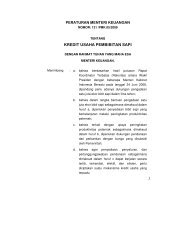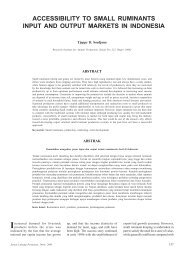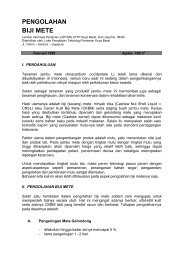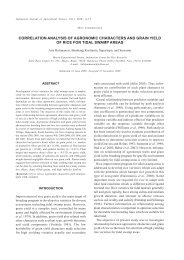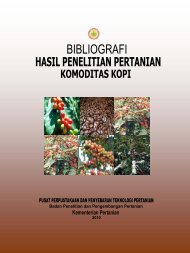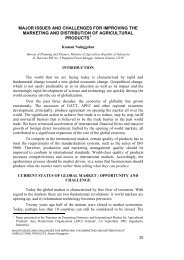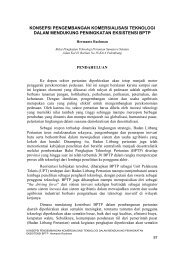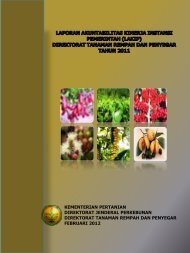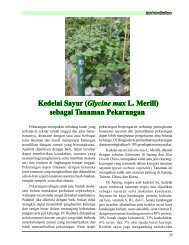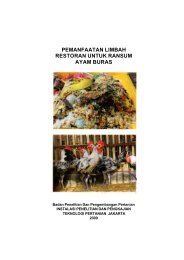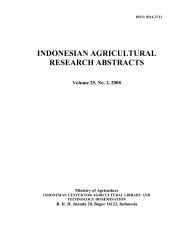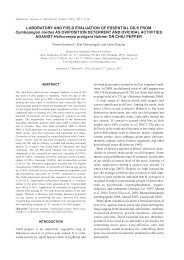DYNAMIC SYSTEM APPROACH TO FIND OUT ... - Pustaka Deptan
DYNAMIC SYSTEM APPROACH TO FIND OUT ... - Pustaka Deptan
DYNAMIC SYSTEM APPROACH TO FIND OUT ... - Pustaka Deptan
Create successful ePaper yourself
Turn your PDF publications into a flip-book with our unique Google optimized e-Paper software.
10 Uning Budiarti et al.Table 1. Predicted figure 1 (PF1), temporary predicted figure(TPF) and constant predicted figure (CPF) on riceproduction, 2001-2005.YearRice production (t)PF1 TPF CPF TPF-CPF 1)(%)2001 50,081 49,590 50,461 (0.76)2002 48,654 51,379 51,490 (5.83)2003 51,400 52,079 52,138 (1.44)2004 53,100 54,061 54,088 (1.86)2005 53,117 54,056 54,056 (1.77)Average (2.33)1)Calculated.Source: Central Bureau of Statistics (2006).the same, then the model could be accepted to be used topredict the rice production. The data published by CentralBureau of Statistics (2006) were presented in Table 1.RESULTS AND DISCUSSIONThe scarcity of rice stock frequently happening at famineseason will encourage the increases in the rice price andinflation rate, as it happened in December 2006. Rice importbecomes an option that has to be taken when the ricedemand is higher than the production (Amrullah 2003).However, import is only a short-term solution for the foodproblem. In a longer term, the government has determinedto increase rice production, hence the Indonesian foodsustainability is guaranteed. As it was mentioned before,there is a discrepancy between the potential and actualrice milling recoveries as presented in Figure 3.Simulation was used to estimate the rice production forthe next 5 years compared to the rice demand. Productionincrease was carried out by two methods, i.e. by reducingloss causing land productivity improvement, and secondlyby improving the machine configurations of SSRMs andRMUs from HP to HSP and CHSP configuration. Theimprovement of this configuration increased the rice millingrecovery. The prediction obtained from this simulation areused for basic data, i.e. dried paddy production having anerror of < 1% and less than the error of predicted figureconducted by CBS on the constant predicted figures aspresented in Table 2.The simulation results using dynamic system approachis presented in Table 3 and Appendix 1-6. It can be seen inTable 3 that without technological improvements throughthe renovations of SSRMs, the reduction of loss, riceproduction increase cannot catch up with the consumptionincrease. This results in a deficit every year. The deficitcan be reduced up to more than 80% by renovating SSRMs.If the renovations of SSRMs are accompanied by otherpostharvest loss reductions, the deficit will decrease evenmore, and it may result in a surplus in 2010. These resultsshow that improvement efforts on postharvest paddy arevery important as they provide large potencies in increasingthe national rice production and guarantying food selfstuffiness.75706560Actual55Potency01970 1985 1999 2000Figure 3. Actual vs. potential rice milling recoveries.
Dynamic system approach to find out mechanization model... 11Table 2. Comparison of prediction carried out by model and Central Bureau of Statistics, 2001-2005.Model predictionCBS predictionYear Model CBS (CPF) Difference (%) PF 1 TPF CPF TPF - CPF 1) (%)2001 1,995 50,461 2.95 50,081 49,590 50,461 (0.76)2002 52,431 51,490 1.79 48,654 51,379 51,490 (5.83)2003 52,872 52,138 1.39 51,400 52,079 52,138 (1.44)2004 53,317 54,088 (1.45) 53,100 54,061 54,088 (1.86)2005 53,766 54,056 (0.54) 53,117 54,056 54,056 (1.77)Average 0.83 (2.33)1)Calculated.Source: Central Bureau of Statistics (2006).Table 3. Predictions on rice production and deficit in Indonesia, 2007-2000.Rice production (t)2007 2008 2009 2010National rice consumption 34,502,306 34,904,757 35,385,122 35,835,481Rice production without renovation 33,876,051 34,268,191 34,750,880 35,275,007Rice production with renovation 34,350,941 34,751,995 35,244,909 35,779,894Rice production with renovation and loss reduction 34,367,757 34,805,700 35,344,529 35,929,978Deficit without rice mill renovation 626,255 636,566 634,242 560,474Deficit with rice mill renovation 151,365 152,762 140,213 55,587Deficit with rice mill renovation and loss reduction 134,549 99,057 40,593 (94,497)Milling recovery without renovation 62.78 62.78 62.78 62.78Milling recovery with renovation 63.66 63.66 63.67 63.68CONCLUSIONThe simulation outcome of the dynamic system producesa prediction for the years 2007-2010, that without postharvesttechnological improvement there will be asignificantly high rice deficit ranging from 500,000 to600,000 tons. The deficit can be reduced by improving thetechnologies such as the improvements of productionprocess (on farm), the postharvest by utilizingmechanization technologies, especially the renovation onmachine configurations of small scale rice mills. Rice millrenovation can increase the average national millingrecovery from 62.75 to 63.68%. Therefore, they reduce thenational rice deficit and if they are combined with effortson postharvest loss reduction, the deficit of rice stock willbe more quickly happen and it is even predicted that therewill a surplus in 2010.REFERENCESAmrullah, S. 2003. Kebijakan Ekonomi Beras Indonesia. PuslitbangBulog, Jakarta.Budihardjo, E. 1995. Pendekatan Sistem dan Tata RuangPembangunan Daerah untuk Meningkatkan Ketahanan Pangan.UGM Press, Yogyakarta.Central Bureau of Statistics. 2006. Statistics of Indonesia. CentralBureau of Statistics, Jakarta.Direktorat Pengolahan dan Pemasaran Hasil Tanaman Pangan.2002. Pengembangan Agribisnis Perberasan Berbasis PenggilinganPadi. Direktorat Pengolahan dan Pemasaran HasilTanaman Pangan, Ditjen Bina Pengolahan dan Pemasaran HasilPertanian. Jakarta.Ministry of Agriculture, Forestry and Fisheries of Japan. 1995.Rice Postharvest Technology. The Food Agency, Ministry ofAgriculture, Forestry and Fisheries of Japan.Richardson, G.P. 1983. Introduction to System Dynamics Modelingwith Dynamo. MITT Press, Cambridge, Massachusetts.
12 Uning Budiarti et al.Tasrif, M. 2005. Pelatihan Sistem Dinamik (Modul Pelatihan).Program Magister Studi Pembangunan Institut TeknologiBandung.Thahir, R. 2002. Tinjauan Penelitian Peningkatan Kualitas BerasMelalui Perbaikan Teknologi Penyosohan. Balai BesarPengembangan Mekanisasi Pertanian, Serpong.Tjahjohutomo, R., Harsono, A. Asari, T.W. Widodo, dan U.Budiharti. 2003. Laporan Hasil Penelitian TA 2003. BalaiBesar Pengembangan Mekanisasi Pertanian, Serpong.Tjahjohutomo, R., Harsono, A. Asari, T.W. Widodo, dan U.Budiharti. 2004. Pengaruh Konfigurasi Penggilingan PadiRakyat terhadap Rendemen dan Mutu Beras Giling. Balai BesarPengembangan Mekanisasi Peratanian, Serpong.



